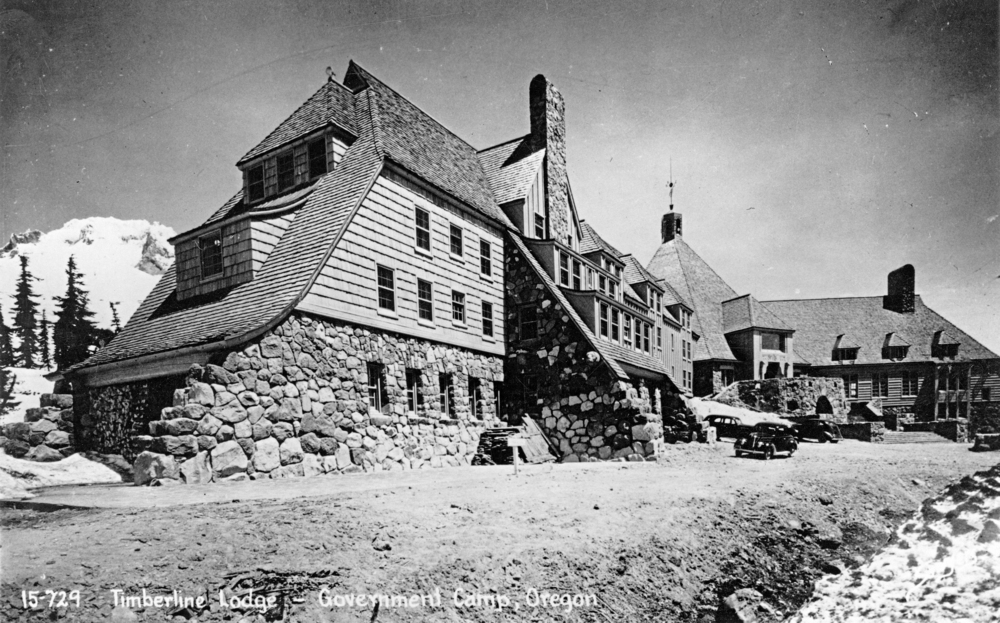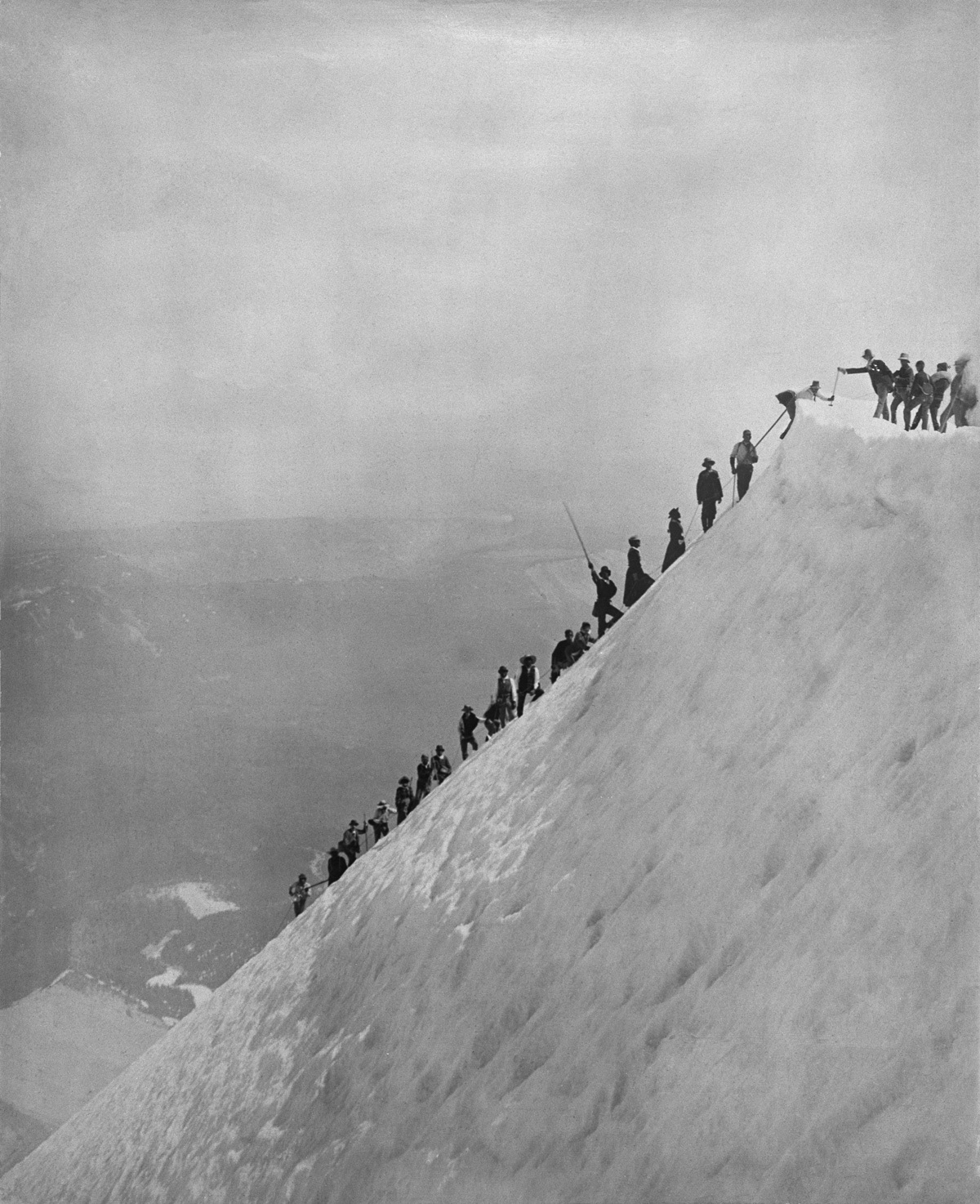Timberline Lodge is the showplace for Works Progress Administration projects in Oregon. Its construction was financed with nearly a million dollars from the WPA, with additional funding from the Federal Art Project for furnishings and art. Emerson J. Griffith, Oregon's WPA director, spearheaded the Timberline project by submitting applications for funding and promoting it as an icon of the WPA.
When the first WPA funds became available in December 1935, Gilbert Stanley Underwood was selected as consulting architect. Underwood had already designed lodges in several national parks, including Bryce Canyon and Yosemite. Timberline was designed in a similar rustic style to the national park lodges, with their asymmetrical design, the use of native materials, and a roughness reminiscent of pioneer craftsmanship. Underwood also suggested decorative pioneer and Indian themes, although no Native Americans were consulted in selection of so-called Indian motifs. Working with Underwood, U.S. Forest Service architects Tim Turner, Linn Forrest, Howard Gifford, and Dean Wright drew the plans for Timberline, including sketches for the wrought-iron detailing and some of the rustic wood furniture.
Workers came primarily from the WPA, but some jobs—including excavation, road building, and laying the terraces—were performed by younger men in the Civilian Conservation Corps (CCC). The WPA workers lived at Summit Meadow, and CCC workers came from Camp Zigzag. The construction was supervised by a private contractor, Lorenz Brothers.
Margery Hoffman Smith, the assistant state director to the Federal Art Project in Oregon, was the interior designer for the lodge. Murals, paintings, and carvings for the lodge were commissioned from some of Oregon's most accomplished artists, including Darrel Austin, C.S. Price, Howard Sewall, Charles Heaney, Erich Lamade, Florence Thomas, Virginia Darcé, and Douglas Lynch. Smith integrated designs for wood furnishings, wrought-iron detailing, and textile patterns to create a unique mountain resort. Two important objectives of the WPA were to develop independence through training and to encourage private enterprise. In 1976, Smith remembered: "Carpenters became cabinet makers, blacksmiths became art metal workers and sewing women wound up expert drapery makers."
Ray Neufer supervised the Oregon WPA woodworking shop that produced the furniture. Many of the workers who carved the newel posts were inexperienced carvers. In a radio program about the project, Neufer said: "Most of the men came in from construction projects and they didn't know they could do some of the things they did. Most of them had been out of work a long time, then on construction jobs, and they had lost their self-confidence."
Several architectural elements are repeated throughout the lodge. A curved post and lintel arch, looking rather like a haystack, is so prevalent in the lodge, appearing in many doorways and in chairs and mirrors, that it has become known as the Timberline Arch. Hexagons also appear throughout the lodge in the shape of coffee tables and the angled couches in the main lobby.
O.B. Dawson supervised the metal shop, and his workers produced beautiful hand-wrought iron decorative details on doors, light fixtures, andirons, and gates. Dawson designed fireplace andirons, screens, and fire tools and worked on the distinctive coyote head wrought-iron gates to the Cascade Dining Room. Dawson later wrote in the Oregon Historical Quarterly that several motifs had been tried and rejected for the gates, but no one could agree on which elements to use. He remembered receiving a phone call from lead contractor Max Lorenz that triggered what must have been a frenetic work day in the blacksmith shop: "Max wanted to know if I had any ornamental motifs made. I told him that I had ornament motifs scattered all over the shop but that none of the ‘powers that be' could decide what they wanted. Max said to forget what anyone else says, put what ornament motifs you have in the gates and get them up here. So we did."
Women held few jobs under the WPA, but many were employed by the Women's and Professional Project to sew appliquéd draperies, weave fabrics for bedspreads and upholstery, and hook rugs for the lodge. Because only one member of a family could be employed by the WPA, the women's division employed mostly unmarried, divorced, or widowed women.
In the early fall of 1937, President Franklin D. Roosevelt and Eleanor Roosevelt arrived in Oregon to dedicate Bonneville Dam and Timberline Lodge. They left Bonneville Dam on September 28 in an open touring car, accompanied by a motorcade of forty vehicles. As they drove on the Mount Hood Loop Road, mounted Forest Service personnel lined up to salute and wave.
After entering Timberline Lodge, Roosevelt took the elevator to the main floor and went out on the terrace overlooking the main entrance, facing south toward Mount Jefferson (now called the Roosevelt Terrace). He talked about the future recreational benefits of the lodge and emphasized the economic value of forests for timber, livestock, game, and water. "This Timberline Lodge marks a venture that was made possible by WPA emergency relief work," he said, "in order that we may test the workability of recreational facilities installed by the Government itself and operated under its complete control." About 150 invited guests went inside for lunch and were entertained by members of the string ensemble of the WPA orchestra.
Oregon's WPA Director, Emerson J. Griffith, turned the lodge over to the U.S. Forest Service in January 1938, and the lodge opened to the public under operation by Timberline Lodge, Inc., on February 4-5, 1938. The Riblet Tramway Co. engineered and constructed the Magic Mile chairlift, and the WPA built Silcox Warming Hut at the top of the lift. Silcox Hut, at 6,950 feet, was abandoned in 1962 when the chairlift was moved west to escape snow accumulation. Friends of Silcox Hut renovated the hut in the early 1990s and added bunkrooms in the former lift area.
Timberline Lodge was closed during World War II. After it reopened in 1945, the lodge and ski facilities were not properly maintained and the Forest Service revoked the operating permit in 1955. Within months, Richard L. Kohnstamm was granted the permit. Kohnstamm cleaned up the lodge, re-established ski education programs, built an outdoor swimming pool (1958), and planned festive events that made the lodge increasingly popular among Oregonians. In 1975, convention facilities (the C. S. Price Wing) were added at the east end of the lodge, and the Wy'East Day Lodge was built across the parking lot in 1981 to provide services for skiers. Kohnstamm died in 2006, and his family continues to operate the lodge through R.L.K. and Company.
Timberline Lodge was declared a national landmark in December 1977. It hosts more than two million visitors each year.
-
![]()
Timberline Lodge, Mount Hood.
Oregon Historical Society ba011745
-
![]()
Timberline Lodge, Mount Hood, January 1937.
Oregon Historical Society bb004277
-
![Angelus Commercial Studio.]()
Timberline Lodge and Mount Hood.
Angelus Commercial Studio. Oregon Historical Society Research Library, Digital Collections, OrgLot78_B2F7_008
Related Entries
-
![Charles Edward Heaney (1897-1981)]()
Charles Edward Heaney (1897-1981)
Charles Heaney was a printmaker and painter in Oregon for nearly sixty …
-
![Clayton Sumner (C.S.) Price (1874-1950)]()
Clayton Sumner (C.S.) Price (1874-1950)
Clayton Sumner (C.S.) Price, a pioneering American expressionist, made …
-
![Darrel Austin (1907-1994)]()
Darrel Austin (1907-1994)
Darrel Austin, an Oregon artist who gained a national reputation, was b…
-
![Margery Hoffman Smith (1888-1981)]()
Margery Hoffman Smith (1888-1981)
Margery Hoffman Smith, a painter and interior designer, was called the …
-
![Mount Hood]()
Mount Hood
Mount Hood is a stratovolcano in northwest Oregon located about fifty m…
-
![Richard L. Kohnstamm (1926-2006)]()
Richard L. Kohnstamm (1926-2006)
Richard L. Kohnstamm was the president and area operator of Timberline …
-
![Zigzag Ranger Station]()
Zigzag Ranger Station
Zigzag Ranger Station is the headquarters for the Zigzag District of th…
Related Historical Records
Map This on the Oregon History WayFinder
The Oregon History Wayfinder is an interactive map that identifies significant places, people, and events in Oregon history.
Further Reading
Dawson, Orion B. "The Ironwork of Timberline." Oregon Historical Quarterly 76 (3): 259-68, 1975.
Fulton, Eleanor Ann. "Historic American Building Survey: Timberline Lodge." HABS No. OR-161.1995.
Munro, Sarah. Timberline Lodge: The History, Art and Craft of an American Icon. Portland, Oregon: Timber Press, 2009.
Rose, Judith, ed. Timberline: A Love Story, Portland: Friends of Timberline and Graphic Arts Center Publishing Company, 1986.









